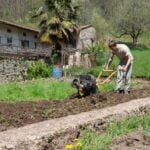Introduction
Vegetable gardening provides multiple benefits such as fresh produce, relaxation, and health benefits. Fresh produce is great because you know exactly what went into growing it and that it isn’t saturated with pesticides or herbicides. You also have the added satisfaction of having grown it yourself and being able to stumble onto a vine-ripened tomato for dinner or snack. In addition, relaxing in your garden can help reduce stress. Gardening has also been known to increase the activity of certain endorphins which promotes one’s sense of well being, ultimately leading to improved overall mental health. Finally, eating vegetables you have grown yourself is a great way to promote physical health by providing better nutrition through eating fresher foods than can be found in most retail outlets today.
When watering a vegetable garden, it is important to find the right balance between underwatering and overwatering. Vegetables generally need 1-2 inches of water per week during their growing season (generally spring through fall). This water can come from rain, irrigation systems, and/or occasional hand-watering if necessary. An important step when watering any garden is monitoring the soil moisture levels to make sure plants are getting enough but not too much water since too much moisture can lead to fungal diseases and root rot. Additionally, adding compost or mulch adds nutrients as well as helps conserve water by reducing evaporation.
Factors That Affect How Much Water Your Vegetable Garden Needs
The amount of water your vegetable garden needs depends on the type of vegetables you are growing, the season and weather conditions, the state of the soil, and how much sun and shade your garden receives. A good rule of thumb is to apply 1-2 inches of water per week evenly across your entire vegetable garden. This should keep most vegetables in tip-top shape, but some may require more or less depending on their individual needs.
The type of vegetables you are growing will affect how much water they need. Lettuce, spinach, and other leafy greens do not require as much water as tomatoes, peppers and squash. Heavier crops like broccoli and cauliflower may need slightly more moisture than some other vegetables.
The season will also have an effect on how much water your vegetable garden needs. During periods of hot summer days, it’s likely that your plants will require more frequent watering than in cooler autumn months when rain might provide additional moisture.
Weather conditions play a role too. Rainfall may take care of some or all irrigation needs during wet periods; however during times where rainfall is sparse (or nonexistent), supplemental watering from you is usually required to keep plants healthy and flourishing. The same goes for cloudy days or if temperatures drop below freezing—you may find yourself needing to increase the frequency or quantity of irrigation to ensure optimal growth for your veggies during these kinds of situations.
The state that your soil is in can also dictate how much water vegetation requires for healthy growth. Sandy soils allow for faster drainage so generally need more frequent watering; likewise, clay soils hold onto moisture better but are prone to compaction so this can mean less frequent irrigation sessions might be needed throughout the growing season but with longer duration sessions allotted towards each one instead to really penetrate into the earth’s depths.
Finally, sunlight and shade create different conditions within a vegetable garden which means different amounts of water may be required in each area—sunnier spots likely needing more frequent applications to make up for rapid evaporation from warm temperatures while shaded ones might not require quite as many regular drinks over time!
The Best Time to Water Your Vegetable Garden
The best time to water your vegetable garden is early in the morning. This is ideal because it gives the plants plenty of time to absorb moisture before it evaporates due to the high temperatures of the day. Additionally, late night watering can lead to fungal diseases since water takes longer to dry off during the cool evening temperatures.
In order to determine how much water your vegetable garden needs, you should observe the plants. If they are beginning to wilt, or if their leaf color fades, then they need a thorough watering. Generally speaking, well-established gardens need about one inch of water per week and newly planted gardens need more frequent deep soakings (around 2 inches of water per week). In hot climates vegetables may require more frequent watering than in cooler climates.
You can also use a soil moisture meter or ‘Hortometer’ to evaluate the garden’s water needs. A Hortometer measures water depth in soil and usually indicates whether the area requires more or less water for optimal growth essentially taking all guess work out of it. Additionally, mulching is recommended as it helps retain moisture, prevents weeds from growing and regulates soil temperature which boosts plant growth and yields.
Tips for Irrigation and Other Watering Devices
Vegetable gardens require regular watering to stay healthy and thrive. The amount of water a garden needs depends on the type of vegetables, soil condition, and climate. Generally speaking, vegetable gardens need 1 to 2 inches (2.5 to 5 cm) of water a week—watering two or three times per week is usually enough. You can measure how much water your garden is getting by setting out empty cans at various spots and measuring the amount that collects after each session.
When irrigating your vegetable garden there are several ways you can do it, including overhead sprinklers, drip irrigation systems, and soaker hoses. Overhead sprinklers are best for larger plots since they cover quickly but they can cause splashback that can lead to fungal diseases if the foliage gets wet. Drip irrigation systems have emitters that are placed strategically close to plants and slowly provide a steady stream of water without splashing onto the foliage directly. Soaker hoses provide slow watering over an extended period of time—they’re ideal for raised beds, containers, patio pots, or other regions where containers hold plants within foot-long (0.3 m) sections. Moreover, soaker hoses conserve up to 70% more water than overhead sprinklers because their porous materials allow slow seepage from them in contrast to spray droplets from overhead methods evaporating before reaching the soil surface below.
Another great way of providing moisture for your vegetable garden is collecting rainwater with rain barrels for later use as well as mulching heavily around plants in order to reduce evaporation from soil surfaces; this also helps keep weeds down too! Lastly, make sure you’re familiarizing yourself with your local weather conditions as heavy thunderstorms often provide adequate moistening alone; but if dry periods persist consider making use of nearby sources such as ponds, rivers or even public pools where legal to draw some extra water supply!
Calculating How Much Water Your Vegetable Garden Needs
It’s important to keep your vegetable garden adequately hydrated. The amount of water your garden needs will depend on a number of factors, such as the size and type of plants you have, the climate in which you live, and the type of soil and landscaping material used on your property. To calculate exactly how much water your garden needs, you’ll want to consider a few key elements. First, check for signs of moisture stress in plants by examining their color and texture. If you notice signs of wilting, it typically means the plants are lacking in water. Check your soil with a trowel or soil probe and observe how dry it is–it should be damp all the way through from surface to bottom but not saturated with standing water. Next, look at temperatures and humidity levels to gauge weather conditions. Hotter regions usually require more frequent watering than cooler climates do because heat causes greater evaporation from soil surfaces. Finally, confirm what type of irrigation system is available: manual systems should deliver an adequate amount of water to provide an even coverage; automated systems will likely require less attention, but they may need adjustments if plants become dehydrated during drier times of year.
Types of Vegetables and Their Water Requirement
The amount of water a vegetable garden needs can vary depending on the type of vegetables you are growing and what type of climate you live in. Certain vegetables, like lettuce, spinach, and other leafy greens, require more frequent watering than others. These types of vegetables should be watered two to three times per week during dry periods. Other vegetables, such as tomatoes and cucumbers, generally need between one to two inches of water per week during their vegetative stage. Root vegetables like carrots and beets also require consistent moisture but less frequently than leafy vegetables – about once a week should suffice for them. Peppers will benefit from supplemental watering when the temperature gets too hot or after a stretch of dry days. If the sun is scorching the plants quickly, they may need extra water to prevent wilting or burning.
Signs of Underwatering
Underwatering a vegetable garden is one of the most common mistakes made by gardeners. When a vegetable garden is not given enough water, it can cause a variety of issues. Early signs of underwatering include wilting plants, drooping leaves, and dry foliage. More severe consequences may include pest infestations (such as aphids) due to weakened plants, stunted growth, and slower-than-usual ripening times for fruits and vegetables. If unchecked, long-term effects can be even more extreme; small root systems can lead to poor nutrition uptake in soil with less aeration, and some plants will eventually die from dehydration. In order to prevent these side effects, it is important to make sure your vegetable garden is getting enough water on a regular basis.
Signs of Overwatering
When you water your vegetable garden, it’s important to do so with moderation. Too much water can create more problems than it solves and eventually lead to the demise of your vegetables. Signs of overwatering include yellow or wilting leaves that lack luster, roots that look pale and possibly rotten, and steams which appear soft and limp. In addition to these visual cues, other signs of overwatering include an increase in pests such as fungus gnats, root-feeding nematodes, and other unsavory critters. Furthermore, overwatered soil tends to encourage a lack of oxygen presence around the roots due to over saturation which can stunt the growth of vegetables as well as lead to disease or rot. It is important to take into consideration the climate when watering your garden and stick to a schedule that works best for your environment – generally watering thoroughly but not too frequently is advised.
Troubleshooting Common Issues with Over- & Under- watering
One of the most frustrating challenges for any gardener is troubleshooting an issue with over- or under-watering their vegetables. Over-watering can lead to problems like root rot, nutrient deficiencies, and surface ponding. On the other hand, under-watering can lead to shallow roots and an inability for plants to get enough energy and water from their environment. As a general rule of thumb, vegetable garden plants need about 1 inch of water per week during the growing season; however, there are many factors that can influence this number such as soil composition, sunlight exposure, temperature fluctuations, and the size of your container. To better understand what your particular plants need in terms of watering requirements you may want to consider using a kitchen scale to weigh containers before and after watering. This will help you determine how much water is being taken up by plant roots and whether or not it’s sufficient enough for your crops. Additionally, it’s important to pay attention to other signs such as foliage wilting and discolored leaves as they might be indications of an over- or under-watered garden. Lastly, understanding soils can be key in knowing how much water is retained in each specific area resulting in more tailored watering requirements for each section of the garden.
Conclusion
When it comes to maintaining a healthy vegetable garden the golden rule is to keep the soil moist enough so that your vegetables have access to the water they need but not so wet as to suffocate them. Every vegetable is different and may respond differently to watering, and even a small difference in soil type can create stark differences in how much water you will need to apply. There are some basic principles however that should be adhered to when deciding how much water you should give your vegetable garden:
• Water early in the morning or during the cooler parts of the day in order to avoid unwanted evaporation or fungal growth.
• Check on your soil moisture frequently and make adjustments depending on weather conditions – for example, during hot spells increase watering frequency as necessary.
• If your soil seems overly dry, you may need to increase watering amounts until you achieve consistent moisture throughout your garden.
• Consider using mulch or other ground coverings such as wood chips or straw around plants and between rows to further regulate water use.
While there is no exact formula for achieving a healthy balance when it comes to watering your vegetable garden, following these basic tips can help ensure that it receives just enough water without becoming oversaturated and putting too much strain on its growing environment. It may take time and adjustment before you find a routine that works best for your specific situation, but with patience and care your efforts should pay off with bountiful rewards!

If you’re looking to get into vegetable gardening, or are just looking for some tips on how to make your current garden better, then you’ve come to the right place! My name is Ethel and I have been gardening for years. In this blog, I’m going to share with you some of my best tips on how to create a successful vegetable garden.





